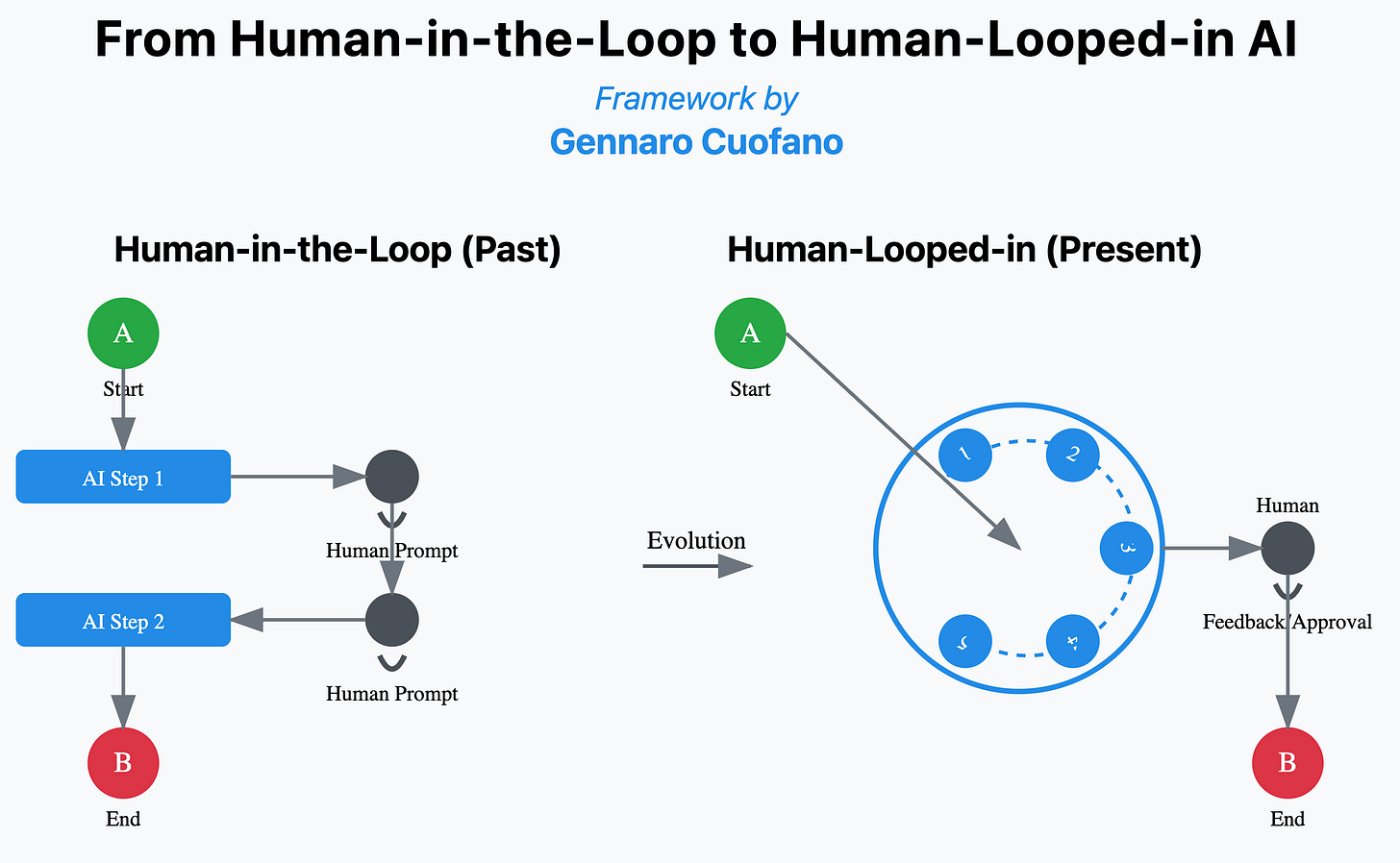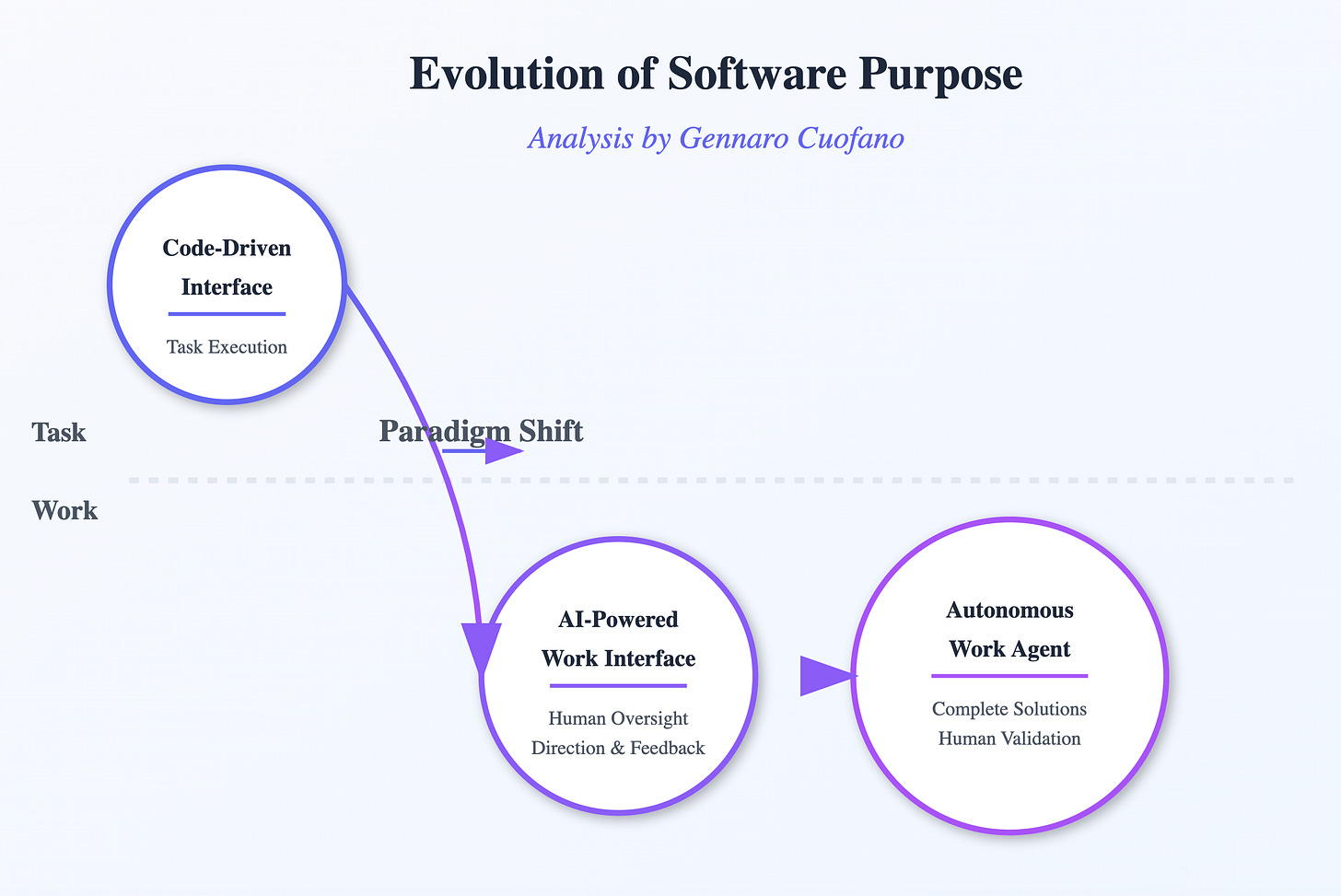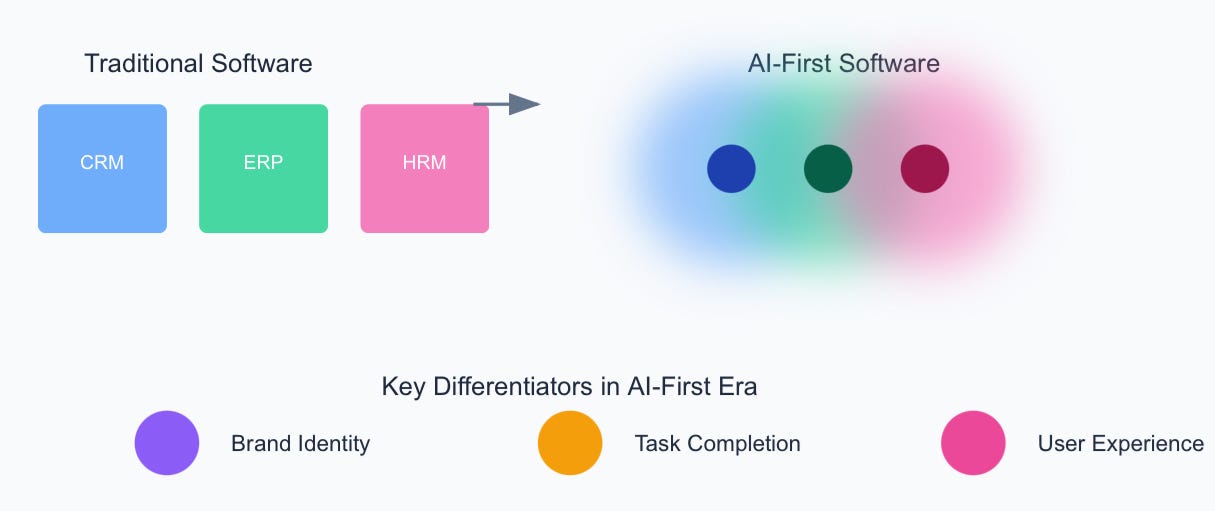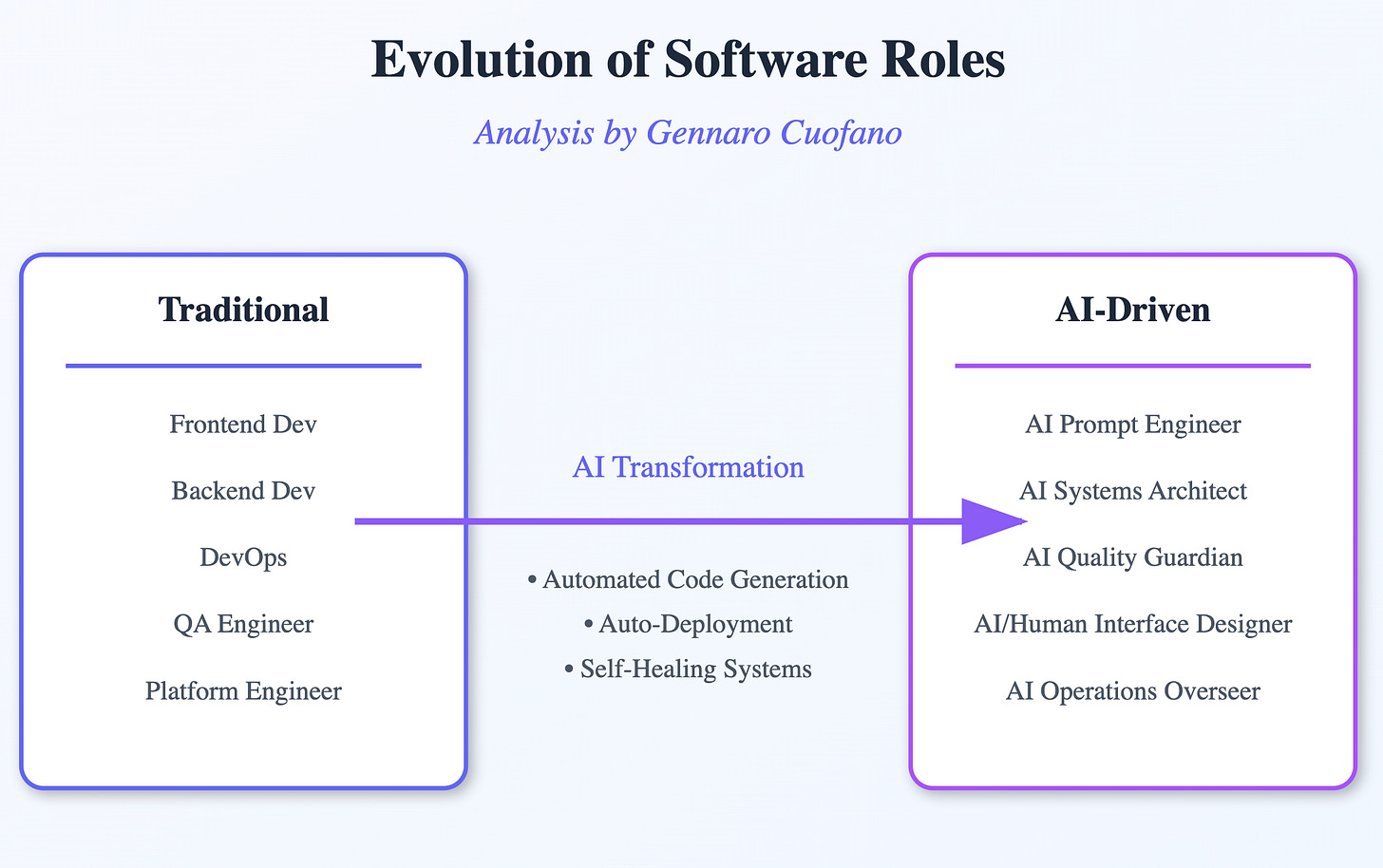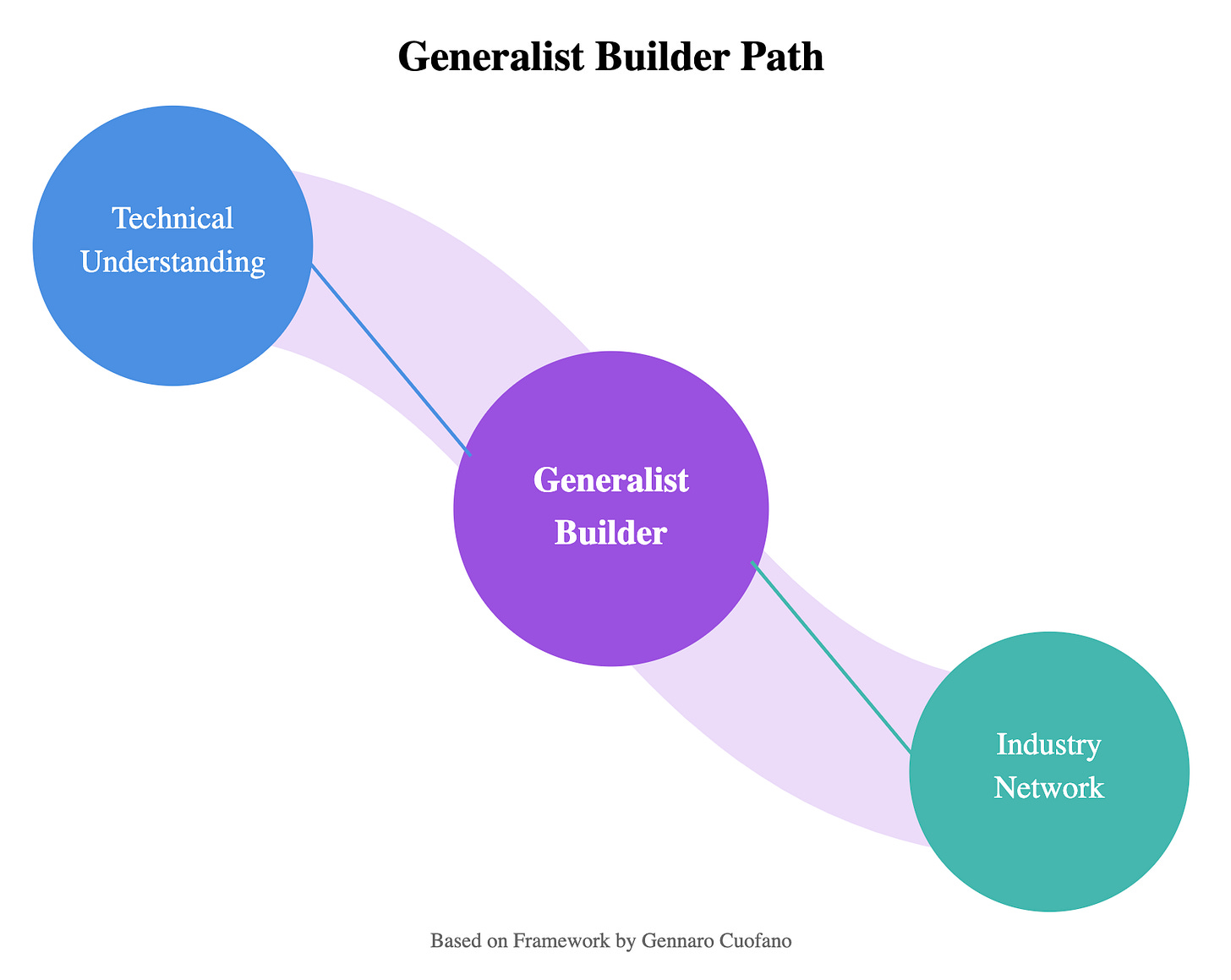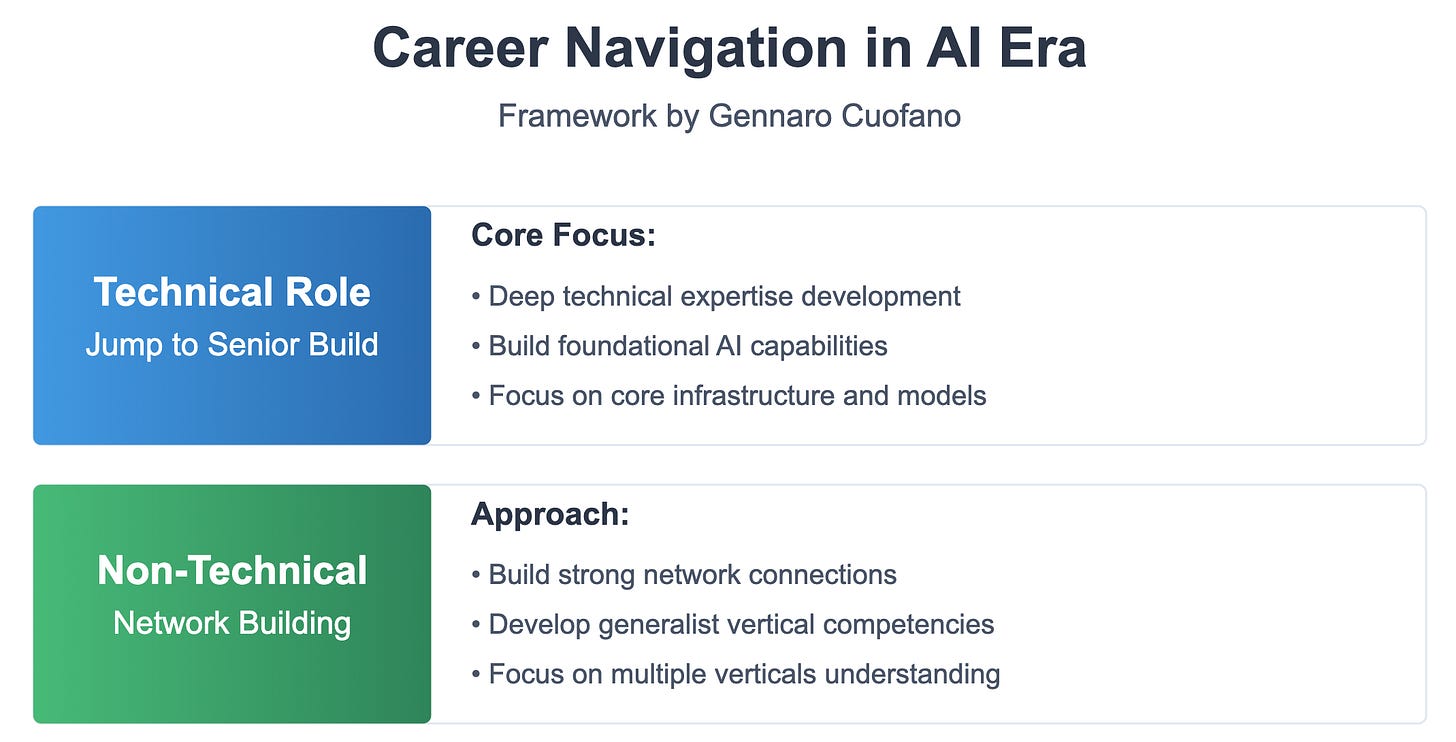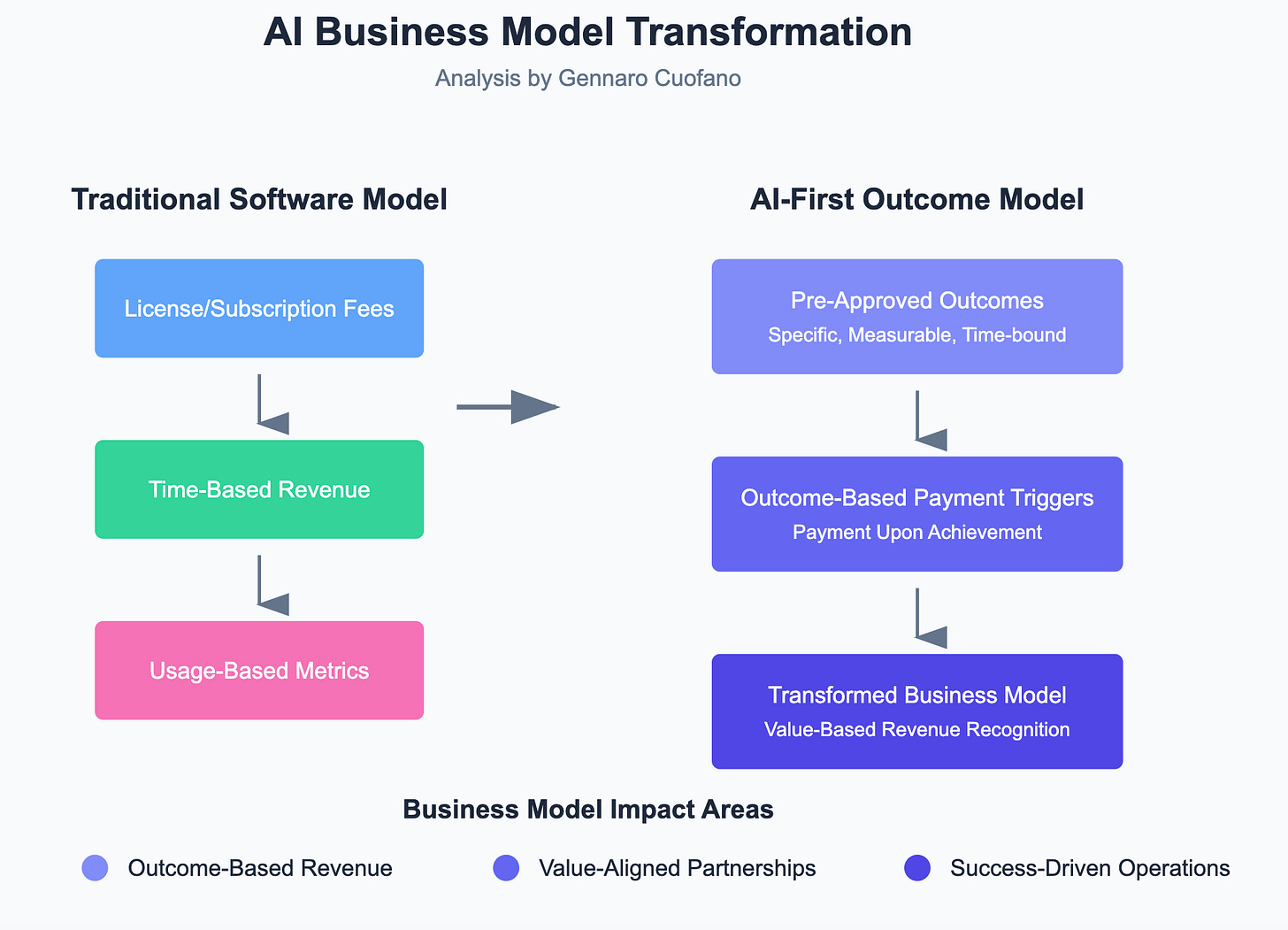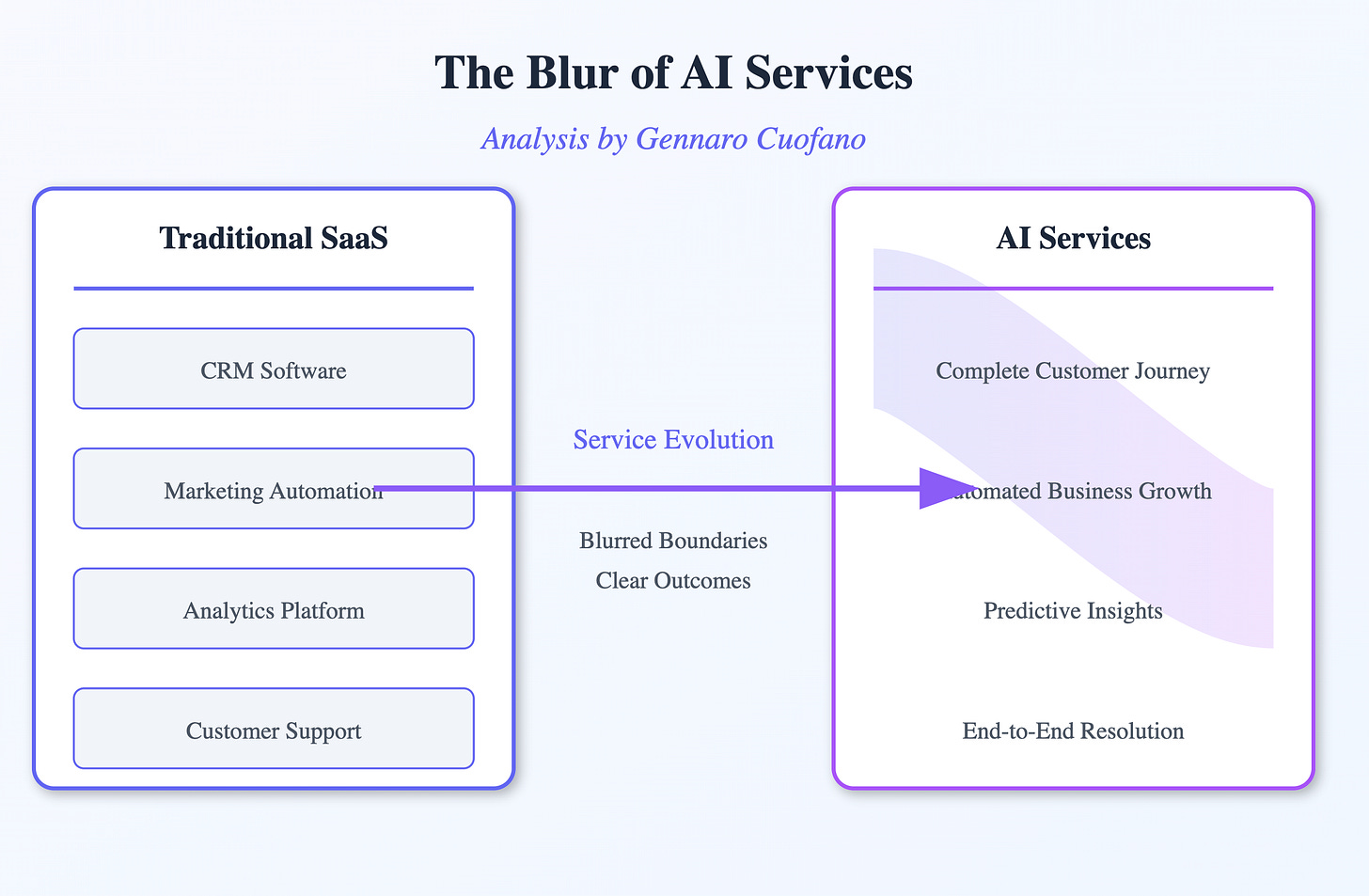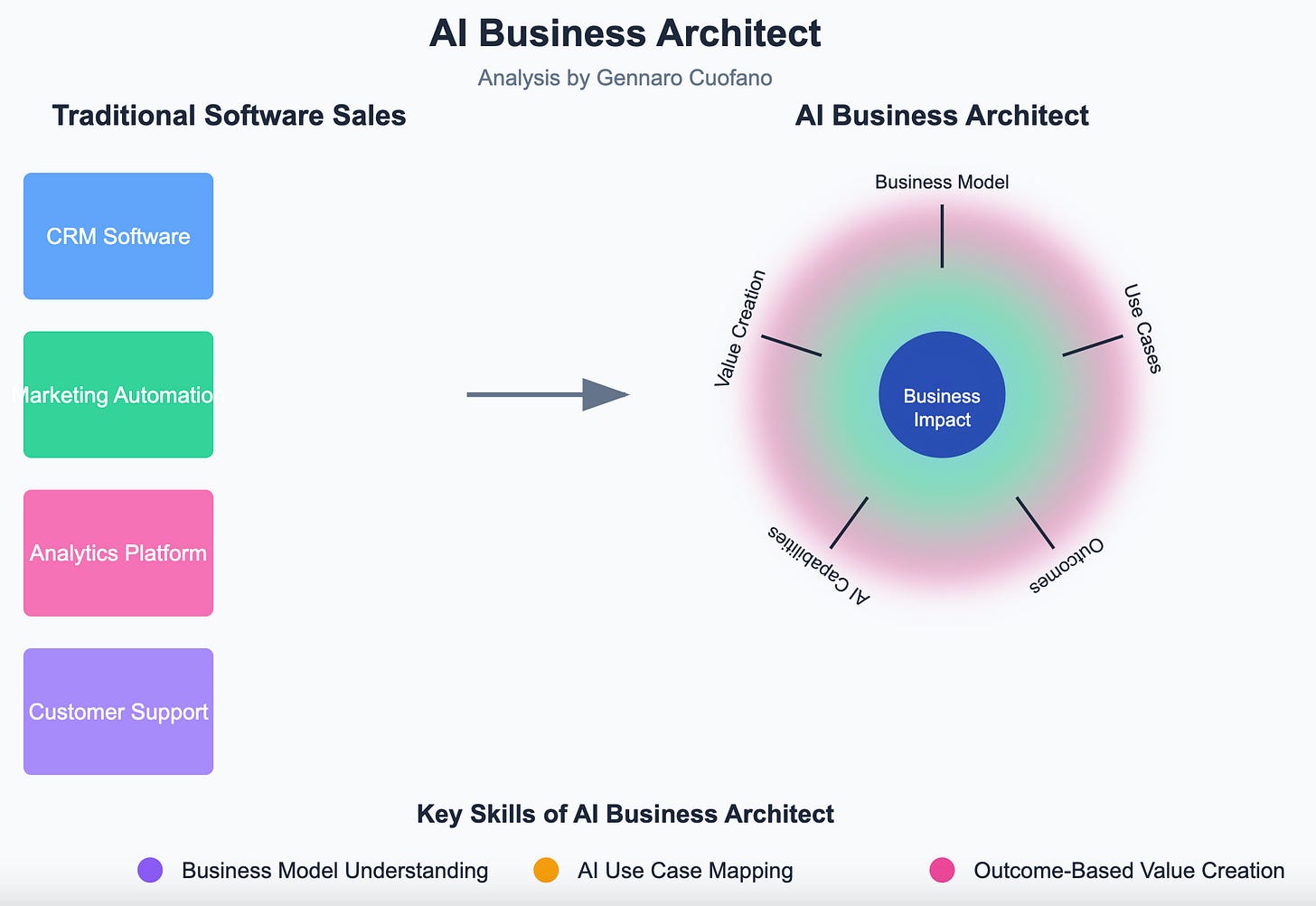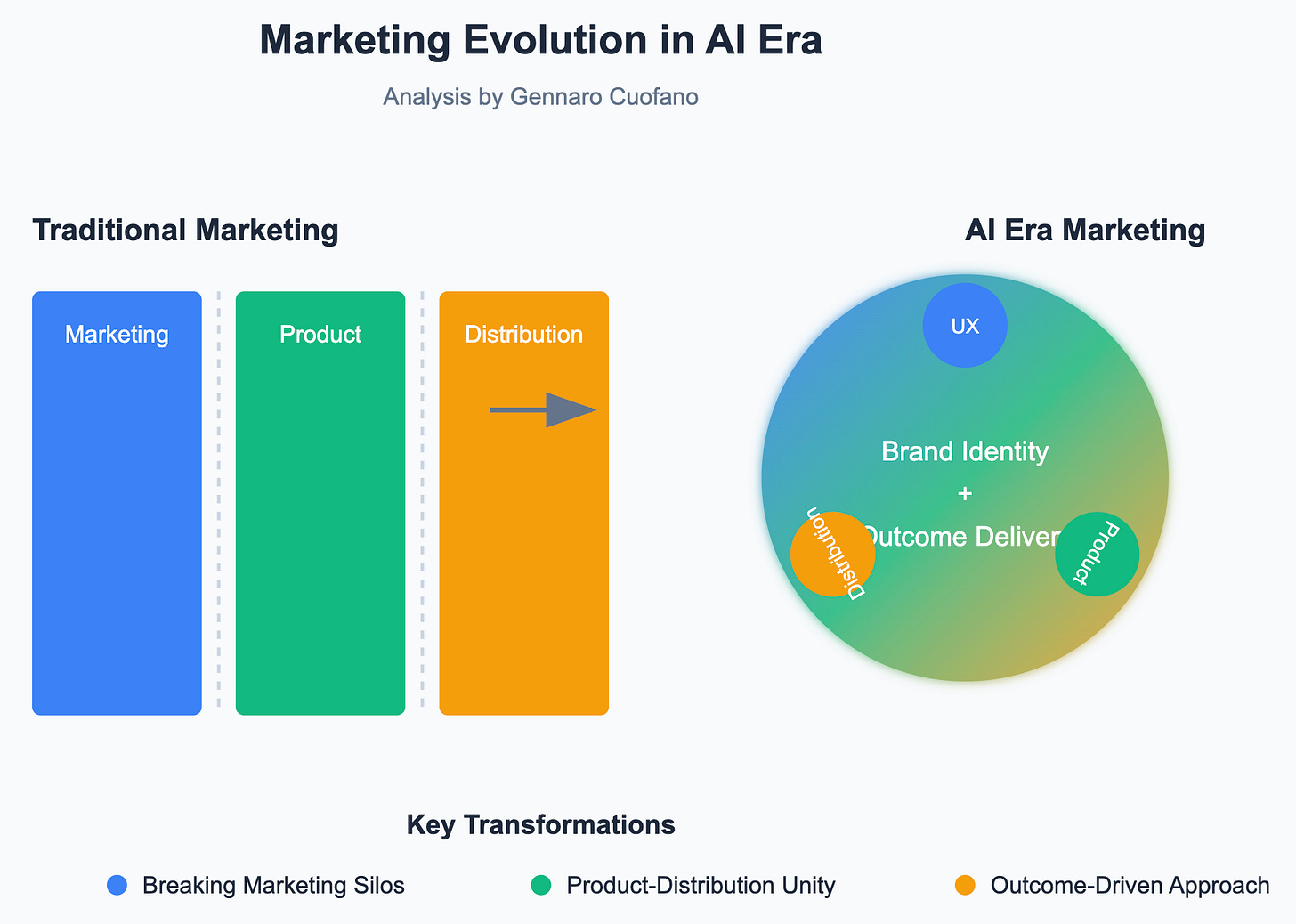
Google’s mission has always been to organize the world’s information and make it universally accessible and useful.
And that’s because this is what it was possible to do back then through the web paradigm.
However, as of now, for Google to survive, its mission should transition to provide the world’s intelligence and make it universally borrowable to get work done.
To be clear, Google won’t be alone there.
Indeed, AI is redefining across the whole set of industries that developed in the web era, the core, underlying definition. Thus, assumptions of what productivity is de facto redefine the whole value chain.
That is why, as I’ve explained, many of these companies are going through a “catalyst moment.”
That is, therefore, cascading back to software.
Indeed, if AI is successful, it will exponentially reduce the cost of making software (code generation has been, at the onset, one of the most impressive capabilities of an LLM). It will also change the industry at its foundation.
That’s how software is changing in the AI era.
Software is no longer just code with human support to complete a task.
Instead, it has evolved into a unit of borrowed intelligence, where AI handles the primary workload, and humans act as a verification layer to refine the outcome.
To be clear, as of now, we’re just looking at a shift and transition from “human-in-the-loop” to “human-looped-in,” where the amount of “tasks space” the machine can manage independently is getting broader and wider.
In human-in-the-loop AI, humans prompt the system to travel from point A to point B, guiding each step with explicit instructions.
In contrast, human-looped-in-AI empowers the agent to independently complete the entire cycle of tasks, with human involvement limited to providing strategic feedback or final approval.
This shift transforms software from a static tool into a dynamic, intelligent system that continuously learns and adapts, making human intervention more about oversight than execution.
As AI advances, software becomes an autonomous agent capable of decision-making and problem-solving, fundamentally redefining productivity, efficiency, and the role of humans in the digital landscape.
On the application side, that also clearly blurs the boundaries between various providers.
Take the case of various enterprise companies like Sierra, Harvey, and Writer AI.
Each player is tackling different use cases (for now) as they fine-tune their enterprise platform to address specific customer problems.
Yet, over time, they will converge in solving for a similar set of use cases just because the available space of what a “single AI use case” will be capable of will expand many times over, compared to what a use case meant in the SaaS era!
In other words, the nature of the “use case” is shifting from relatively narrow and task-support-based to much broader and outcome-based.
Suppose I’m an enterprise business in legal, finance, or marketing. In that case, I might “employ an AI” not to perform a pretty narrow task but to get a specific outcome that changes everything.
That doesn’t mean domain-specific applications won’t exist, but their reach will expand beyond the traditional “software use case.”
That makes the boundaries in the software industry quite blurred.
This is part of an Enterprise AI series to tackle many of the day-to-day challenges you might face as a professional, executive, founder, or investor in the current AI landscape.
If we look at traditional software categories:
-
CRM (Customer Relationship Management): Software that manages a company’s interactions with current and potential customers.
-
ERP (Enterprise Resource Planning): Software that manages day-to-day business activities such as accounting, procurement, project management, risk management, and supply chain operations.
-
HRM (Human Resource Management): Software that manages human resources, including payroll, benefits, and employee data.
AI breaks these barriers.
In short, with a software paradigm that changes from quite specialized, narrow, and task-based to generalized, broad, and outcome-based.
That means three things will matter a lot:
-
Effective Architecture on Top for Task Completion: By removing the boundaries that used to define software categories and thus making them fit into a single block of much broader use cases, the custom architecture that enterprise companies will be able to build over time will be one of the critical components of their success.
-
User Experience: On the B2B and enterprise sides, the UI is the main piece of the puzzle. It will be the bridge between the above, the architecture on top to enable task completion, and the below, conveying precisely how your brand differs from others.
-
Brand Identity: The brand identity will result from the two elements above, especially on the enterprise side. In the UX, you convey what your brand is about (for instance, keeping it simple, even when executing complex tasks, might work quite well in specific verticals to make the service distinctive).
That also potentially changes the software profession.
Traditionally, in software, you have various key competencies:
-
Frontend Dev: Developers focusing on software applications’ user interface and user experience.
-
Backend Dev: Developers responsible for integration of server-side logic, databases, and services.
-
DevOps: Professionals who manage the development and operations processes, ensuring smooth deployment and infrastructure management.
-
QA Engineer: Engineers who focus on quality assurance and testing software to ensure it meets quality standards.
-
Platform Engineer: Engineers who work on the underlying platforms and systems that support software applications.
Yet, AI potentially transforms these at various levels:
-
Automated Code Generation: Using AI to generate code automatically.
-
Auto-Deployment: Automating the deployment process using AI.
-
Self-Healing Systems: Systems that automatically detect and fix issues without human intervention.
Thus, a lot of these roles will transition into AI-first roles:
-
AI Prompt Engineer: Professionals who design and optimize prompts for AI systems to generate desired outputs.
-
AI Systems Architect: Architects who design the structure and integration of AI systems within an organization.
-
AI Quality Guardian: Individuals responsible for ensuring the quality and reliability of AI systems.
-
AI/Human Interface Designer: Designers who create interfaces that facilitate interaction between humans and AI systems.
-
AI Operations Overseer: Professionals who oversee the operations and performance of AI systems, ensuring they function as intended.
I’ve tackled what I’ve called the “generalist builder” and how AI breaks the space wide open for this sort of profile.
Of course, that means that AI will make “junior software developers” available by coding AIs from scarce to massively available.
I think this will skew the software career in a direction that makes software and AI a much easier domain to get into, as someone new in the field can jumpstart her/his career with these AI tools.
Yet, that’s the catch: for you to become something highly valuable in a market that is closing the gap on the entry side, is to make yourself as competent as possible on the whole foundational AI models stack, thus giving you the competence of what a few years back was of a 10-year software developer, in 1-2 years, of testing, playing with, and building a lot of stuff in the real world.
Conversely, if you’re a senior software developer able to drive these AI tools, especially at the edge, this decade is already for you, as the market will want you at quite a premium.
The traditional software business model is built around a few key revenue-generating mechanisms:
-
License/Subscription Fees: Companies often use licensing agreements or subscription-based fees to generate income. Customers pay for the right to use the software for a set period, such as annually or monthly.
-
Time-Based Revenue: A significant portion of revenue is tied to the time spent using the software. Billing is usually calculated based on how long the customer can access the system, often with annual or monthly payment cycles.
-
Usage-Based Metrics: In some cases, software companies charge based on the product’s actual usage. This model calculates revenue based on specific metrics like the number of users, transactions, or features accessed.
While effective, these traditional models focus on the duration or frequency of use rather than the value the software provides to the customer.
The AI-first outcome model focuses on delivering tangible, measurable outcomes with:
-
Pre-Approved Outcomes: In the AI-first model, companies set specific, measurable, and time-bound outcomes that are agreed upon in advance. These outcomes are designed to address the customer’s unique needs, ensuring that the focus remains on achieving business goals rather than just delivering a product.
-
Outcome-Based Payment Triggers: Payment is made when predefined outcomes are achieved rather than charging based on time or usage. This method ties payments directly to the results, ensuring customers are only billed when the agreed-upon goals are met. This approach is more aligned with delivering value to the customer.
-
Transformed Business Model: As companies adopt the AI-first outcome model, their business model transforms to focus on value-based revenue recognition. This shift means companies no longer recognize revenue based on time or usage but rather on the value delivered and the outcomes achieved.
The transition to an AI-first outcome model impacts several key areas of a company’s business strategy:
-
Outcome-Based Revenue: Revenue is no longer tied to usage or time but to achieving measurable outcomes. This ensures customers only pay for results, increasing the alignment between customer needs and business objectives.
-
Value-Aligned Partnerships: With an outcome-driven model, partnerships focus more on achieving measurable value. Companies work closely with customers to ensure that both parties are aligned on success, building stronger, more collaborative relationships.
-
Success-Driven Operations: Companies must now operate with the end goal in mind. Business processes, from development to customer service, are increasingly driven by the need to achieve specific outcomes. This shifts the operational focus from simply delivering products to ensuring that those products drive measurable success for the customer.
A potential shift toward AI-native business models will also change the profession, which is usually closer to the customer: the sales profession.
As explained above, in traditional software, you could easily break down the various categories based on narrow tasks they could perform, which made them bucketed under specific verticals, like:
-
CRM Software.
-
Marketing Automation.
-
Analytics Platform.
-
Customer Support.
Yet, AI introduces two key elements:
-
Blurred Boundaries: The distinctions between different service categories become less clear.
-
Clear Outcomes: as boundaries across narrow traditional software verticals become blurred, the outcomes and benefits of these services are more defined and impactful.
That means the sales professional must grasp the business outcome and communicate the value proposition increasingly.
The good news is a great sales professional is already used to doing that. However, with AI-first software, it will be critical for the sales professional to understand, map, and identify where AI can add the most outcome-based value to the organization.
In this specific case, where autonomous systems are getting developed, as we speak, the sales executive will need to focus also on opening up the market by mapping out where the organization can get the most out of it at each stage of development of the AI industry.
On that side, the sales executive becomes an AI Business Architect who must grasp the nuances of the client’s business model to understand which use case can be transformed into an outcome-based agent.
If sales are often quite tactical, meaning they help a business get traction and refine and fine-tune a strategy, then the other key essential layer is the marketing layer.
So, let’s explore how AI might change that, too.
As I’ve explained, in an era where AI moves the use case from narrow to broad, thus blurring the boundaries across traditional software verticals, the marketing element, especially in the form of Brand Identity, becomes critical.
Yet, and that’s the key point, a lot of it will result from the two elements above, especially on the enterprise side.
In the UX, you convey what your brand is about (for instance, keeping it simple, even when executing complex tasks, might work quite well in specific verticals to make the service distinctive).
Thus, while traditional marketing tactics will work, the web has given us a few more tactical marketing levers, like social media, improving the chance of getting something viral.
In reality, the marketing profession must also evolve to break the silos and remove the layers that separate it from the product. In the web era, we learned a valuable lesson: distribution and product are the same thing, giving rise to profiles like the growth marketer.
The jump is even more radical in the AI era, as distribution and outcome should come together.
What that means, going back to the scenario of a company operating in the consumer vs. B2B and enterprise space, more and more, what you stand for is the way your product will achieve that outcome and everything in between.
-
Traditional software was designed to assist human-driven tasks, but AI-first software acts as an autonomous intelligence layer.
-
The shift is from “human-in-the-loop” (guiding AI step-by-step) to “human-looped-in” (AI autonomously completing tasks with human oversight).
-
AI-first software is a self-learning, adaptive system, making human intervention more about strategy than execution.
-
Software categories like CRM, ERP, and HRM are becoming obsolete as AI integrates multiple functions into broader, outcome-driven platforms.
-
Enterprise AI solutions (e.g., Sierra, Harvey, Writer AI) will converge toward solving a common set of industry-wide challenges.
-
Companies no longer buy tools for specific tasks—they employ AI to answer strategic questions and deliver measurable results.
-
Traditional software revenue models (licenses, subscriptions, and usage-based fees) charge for access or usage.
-
AI-first models shift toward pre-approved, outcome-based pricing, ensuring customers pay only for actual business results.
-
This transition aligns businesses with customer success, fostering value-based partnerships rather than transactional relationships.
-
AI is automating many traditional software development tasks, changing key roles:
-
AI Prompt Engineer – Designs and optimizes AI-driven workflows.
-
AI Systems Architect – Builds AI-first software infrastructure.
-
AI Quality Guardian – Ensures AI reliability and performance.
-
AI/Human Interface Designer – Develops AI-driven user experiences.
-
AI Operations Overseer – Manages AI performance and decision-making.
-
-
Junior coding roles will become more accessible due to AI automation, while senior developers specializing in AI will be in high demand.
-
Sales professionals must evolve into AI Business Architects, focusing on:
-
Understanding customer business models and identifying AI-driven opportunities.
-
Mapping AI use cases to specific pain points and optimizing for outcome-based value.
-
Communicating AI’s strategic impact, not just product features.
-
-
Sales is shifting from product-driven to outcome-driven, where AI directly delivers business value rather than just enabling tasks.
-
AI breaks traditional marketing silos, merging distribution, branding, and outcomes into a single, integrated experience.
-
Marketing must evolve from just driving awareness to directly influencing product outcomes.
-
The rise of AI-powered growth marketing means companies must position their brand identity around the results AI delivers.
-
AI-first companies must merge distribution, automation, and intelligence, redefining industry norms.
-
The transition to AI-first operations makes businesses more strategic, adaptive, and value-focused.
-
Companies that fail to transition will lose relevance as AI-native players reshape entire industries.
-
AI transforms software into an autonomous intelligence layer, making traditional software models obsolete.
-
The software industry, sales, and marketing professions must adapt to AI-driven, outcome-based models.
-
AI-native business models dominate by focusing on results, not just access, ensuring companies align revenue with customer success.
With massive ♥️ Gennaro Cuofano, The Business Engineer
This is part of an Enterprise AI series to tackle many of the day-to-day challenges you might face as a professional, executive, founder, or investor in the current AI landscape.

![The Catalyst Quadrant [Mental Models]](https://substackcdn.com/image/fetch/w_140,h_140,c_fill,f_auto,q_auto:good,fl_progressive:steep,g_auto/https%3A%2F%2Fsubstack-post-media.s3.amazonaws.com%2Fpublic%2Fimages%2F5faaf8f9-8489-412f-905c-53258a6468b4_2540x1636.png)

